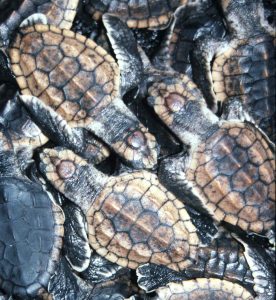Geomagnetic imprinting, natal homing, and mechanisms of magnetoreception in aquatic animals
Kenneth J. Lohmann and Catherine M. F. Lohmann
Department of Biology, University of North Carolina at Chapel Hill, USA
Several marine animals, including sea turtles, salmon and whales, migrate vast distances across seemingly featureless ocean before returning as adults to their area of origin to reproduce. How animals accomplish such feats of natal homing has remained an enduring mystery, but growing evidence implies that some animals imprint on the unique magnetic signature of their natal area and use this information to help them return. In both sea turtles and salmon, subtle changes in the geomagnetic field of the home region were correlated with changes in natal homing behavior, providing strong evidence consistent with geomagnetic imprinting. The ability to derive positional information from Earth’s magnetic field may thus be the centerpiece of long-distance natal homing in ocean migrants, although the mechanisms underlying magnetoreception remain enigmatic. In an attempt to identify candidate genes involved in assembling magnetoreceptors, rainbow trout were exposed to a magnetic pulse strong enough to realign the magnetic dipole moment of magnetite crystals. Analyses revealed differential gene expression in the brains of fish exposed to the pulse relative to the brains of control fish. In particular, the magnetic pulse elicited increased expression in the frim gene, which encodes a subunit of ferritin, the universal iron-binding and trafficking protein. Because magnetic pulses are known to disrupt magnetic orientation behavior in several species, the results are consistent with the hypotheses that geomagnetic imprinting and magnetic navigation are mediated in part by iron-containing magnetoreceptors, possibly composed of magnetite, that must be repaired or replaced after disturbance by a magnetic pulse.









You must be logged in to post a comment.